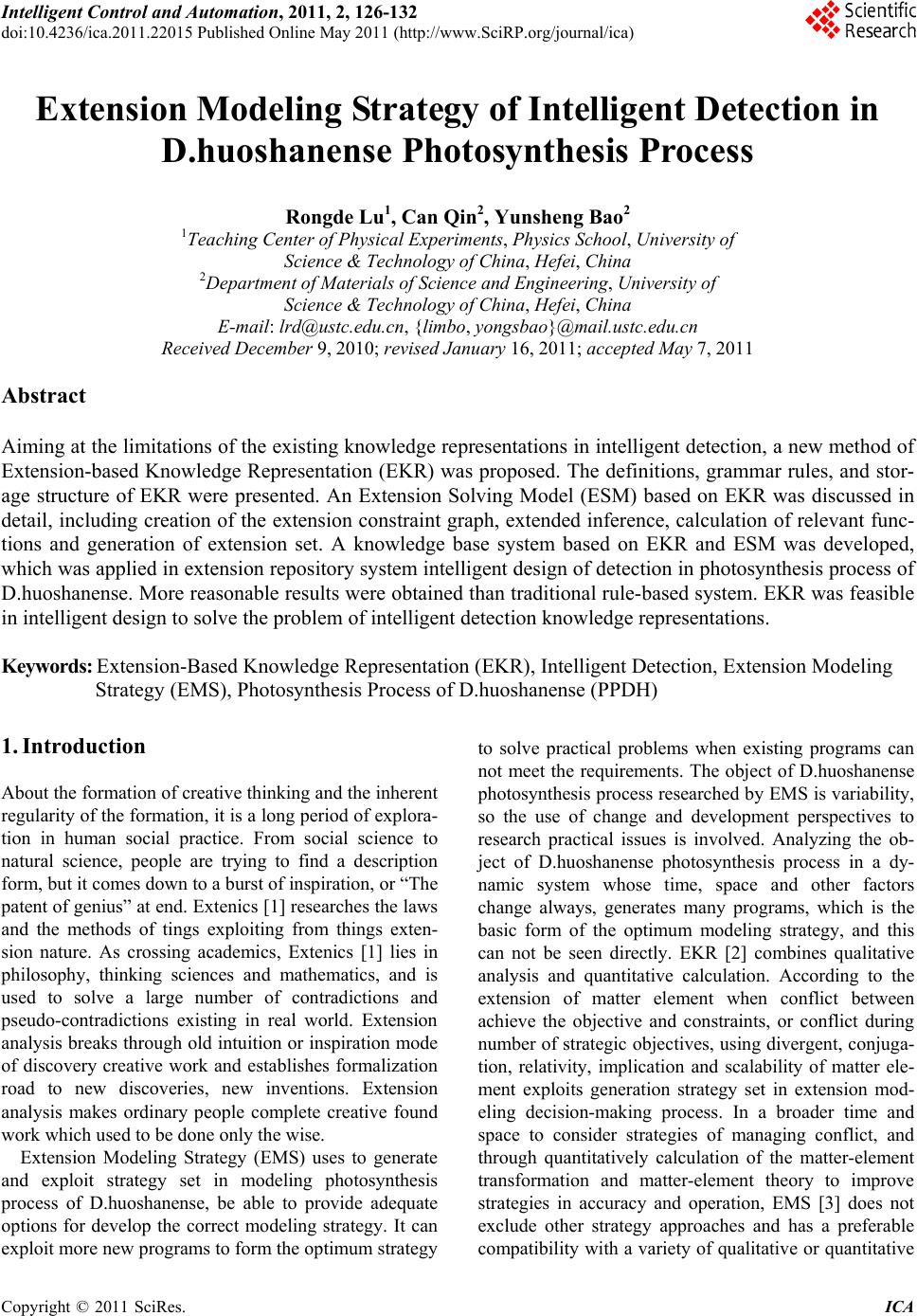 Intelligent Control and Automation, 2011, 2, 126-132 doi:10.4236/ica.2011.22015 Published Online May 2011 (http://www.SciRP.org/journal/ica) Copyright © 2011 SciRes. ICA Extension Modeling Strategy of Intelligent Detection in D.huoshanense Photosynthesis Process Rongde Lu1, Can Qin2, Yunsheng Bao2 1Teaching Center of Physical Experiments, Physics School, University of Science & Technology of China, Hefei, China 2Department of Materials of Science and Engineering, University of Science & Technology of China, Hefei, China E-mail: lrd@ustc.edu.cn, {limbo, yongsbao}@mail.ustc.edu.cn Received December 9, 2010; revised January 16, 2011; accepted May 7, 2011 Abstract Aiming at the limitations of the existing knowledge representations in intelligent detection, a new method of Extension-based Knowledge Representation (EKR) was proposed. The definitions, grammar rules, and stor- age structure of EKR were presented. An Extension Solving Model (ESM) based on EKR was discussed in detail, including creation of the extension constraint graph, extended inference, calculation of relevant func- tions and generation of extension set. A knowledge base system based on EKR and ESM was developed, which was applied in extension repository system intelligent design of detection in photosynthesis process of D.huoshanense. More reasonable results were obtained than traditional rule-based system. EKR was feasible in intelligent design to solve the problem of intelligent detection knowledge representations. Keywords: Extension-Based Knowledge Representation (EKR), Intelligent Detection, Extension Modeling Strategy (EMS), Photosynthesis Process of D.huoshanense (PPDH) 1. Introduction About the formation of creative thinking and the inherent regularity of the formation, it is a long period of explora- tion in human social practice. From social science to natural science, people are trying to find a description form, but it comes down to a burst of inspiration, or “The patent of genius” at end. Extenics [1] researches the laws and the methods of tings exploiting from things exten- sion nature. As crossing academics, Extenics [1] lies in philosophy, thinking sciences and mathematics, and is used to solve a large number of contradictions and pseudo-contradictions existing in real world. Extension analysis breaks through old intuition or inspiration mode of discovery creative work and establishes formalization road to new discoveries, new inventions. Extension analysis makes ordinary people complete creative found work which used to be done only the wise. Extension Modeling Strategy (EMS) uses to generate and exploit strategy set in modeling photosynthesis process of D.huoshanense, be able to provide adequate options for develop the correct modeling strategy. It can exploit more new programs to form the optimum strategy to solve practical problems when existing programs can not meet the requirements. The object of D.huoshanense photosynthesis process researched by EMS is variability, so the use of change and development perspectives to research practical issues is involved. Analyzing the ob- ject of D.huoshanense photosynthesis process in a dy- namic system whose time, space and other factors change always, generates many programs, which is the basic form of the optimum modeling strategy, and this can not be seen directly. EKR [2] combines qualitative analysis and quantitative calculation. According to the extension of matter element when conflict between achieve the objective and constraints, or conflict during number of strategic objectives, using divergent, conjuga- tion, relativity, implication and scalability of matter ele- ment exploits generation strategy set in extension mod- eling decision-making process. In a broader time and space to consider strategies of managing conflict, and through quantitatively calculation of the matter-element transformation and matter-element theory to improve strategies in accuracy and operation, EMS [3] does not exclude other strategy approaches and has a preferable compatibility with a variety of qualitative or quantitative 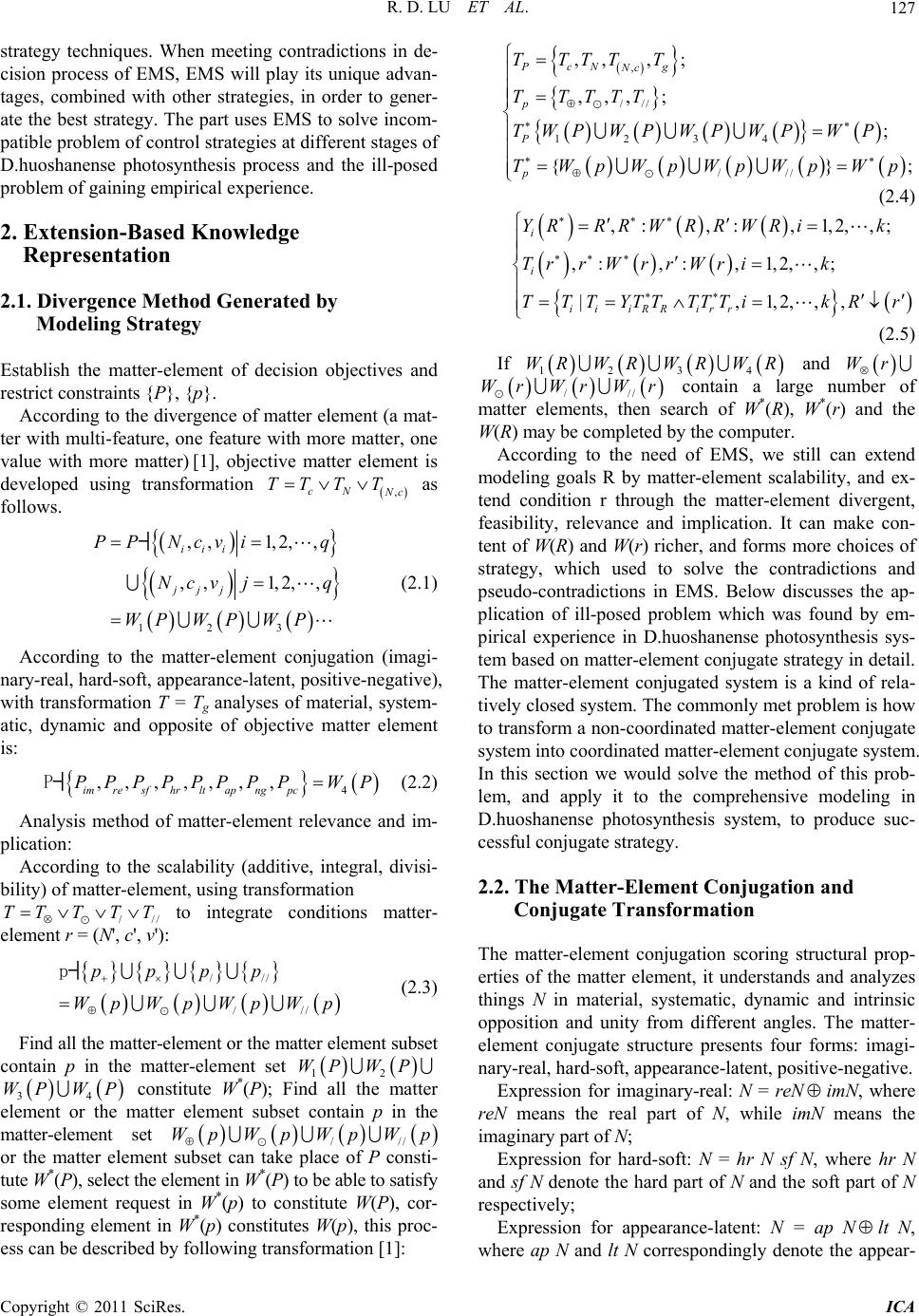 R. D. LU ET AL.127 strategy techniques. When meeting contradictions in de- cision process of EMS, EMS will play its unique advan- tages, combined with other strategies, in order to gener- ate the best strategy. The part uses EMS to solve incom- patible problem of control strategies at different stages of D.huoshanense photosynthesis process and the ill-posed problem of gaining empirical experience. 2. Extension-Based Knowledge Representation 2.1. Divergence Method Generated by Modeling Strategy Establish the matter-element of decision objectives and restrict constraints {P}, {p}. According to the divergence of matter element (a mat- ter with multi-feature, one feature with more matter, one value with more matter) [1], objective matter element is developed using transformation , cN c TT TT as follows. 123 ,,1,2, , ,, 1,2,, iii jjj PP Ncviq Ncvjq WPW PWP ┤ (2.1) According to the matter-element conjugation (imagi- nary-real, hard-soft, appearance-latent, positive-negative), with transformation T = Tg analyses of material, system- atic, dynamic and opposite of objective matter element is: 4 ,,,,,, , im re sfhr ltap ngpc PPPPPPPP WPP┤ (2.2) Analysis method of matter-element relevance and im- plication: According to the scalability (additive, integral, divisi- bility) of matter-element, using transformation /// to integrate conditions matter- element r = (N', c', v'): TT T TT /// /// pppp WpWpWpWp p┤ (2.3) Find all the matter-element or the matter element subset contain p in the matter-element set 12 WP WP , /// 1234 /// ,,, ; ,,, ; ; {} PcNg Nc p P p TTTTT TTTTT TWPWPWPWP WP TWpWpWpWpWp ; (2.4) ,:,:,1,2,,; ,:,:, 1,2,,; |,1,2,,, i i iiiRRirr YRRRWR RWRik TrrWr rWr ik TTTYTTTTTikR r (2.5) If 1234 WR WR WRWR and Wr /// Wr WrWr contain a large number of matter elements, then search of W*(R), W*(r) and the W(R) may be completed by the computer. According to the need of EMS, we still can extend modeling goals R by matter-element scalability, and ex- tend condition r through the matter-element divergent, feasibility, relevance and implication. It can make con- tent of W(R) and W(r) richer, and forms more choices of strategy, which used to solve the contradictions and pseudo-contradictions in EMS. Below discusses the ap- plication of ill-posed problem which was found by em- pirical experience in D.huoshanense photosynthesis sys- tem based on matter-element conjugate strategy in detail. The matter-element conjugated system is a kind of rela- tively closed system. The commonly met problem is how to transform a non-coordinated matter-element conjugate system into coordinated matter-element conjugate system. In this section we would solve the method of this prob- lem, and apply it to the comprehensive modeling in D.huoshanense photosynthesis system, to produce suc- cessful conjugate strategy. 2.2. The Matter-Element Conjugation and Conjugate Transformation constitute W*(P); Find all the matter element or the matter element subset contain p in the matter-element set 34 WP WP /// WpWpWp or the matter element subset can take place of P consti- tute W*(P), select the element in W*(P) to be able to satisfy some element request in W*(p) to constitute W(P), cor- responding element in W*(p) constitutes W(p), this proc- ess can be described by following transformation [1]: Wp The matter-element conjugation scoring structural prop- erties of the matter element, it understands and analyzes things N in material, systematic, dynamic and intrinsic opposition and unity from different angles. The matter- element conjugate structure presents four forms: imagi- nary-real, hard-soft, appearance-latent, positive-negative. Expression for imaginary-real: N = reN imN, where reN means the real part of N, while imN means the imaginary part of N; Expression for hard-soft: N = hr N sf N, where hr N and sf N denote the hard part of N and the soft part of N respectively; Expression for appearance-latent: N = ap N lt N, where ap N and lt N correspondingly denote the appear- Copyright © 2011 SciRes. ICA 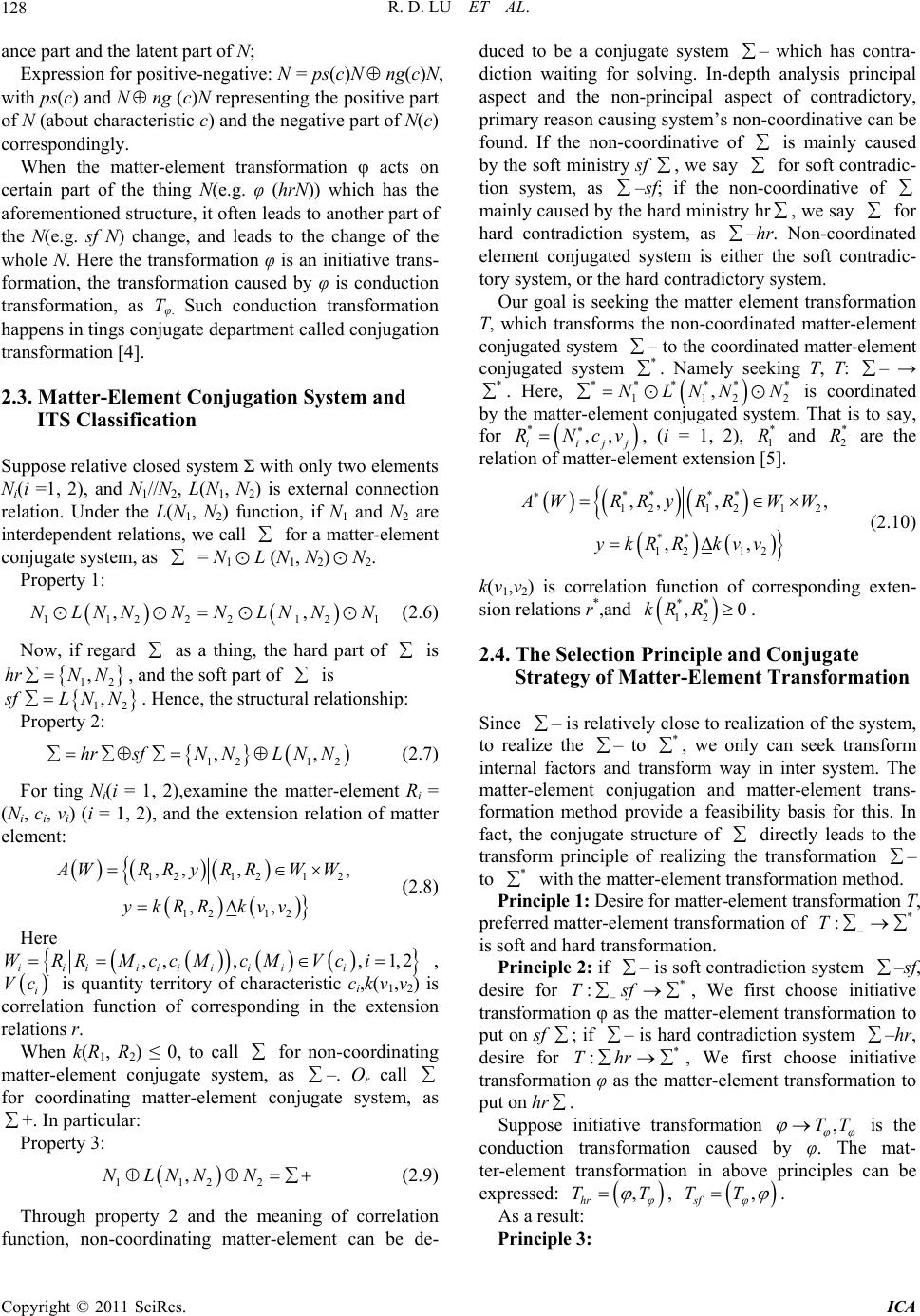 R. D. LU ET AL. 128 ance part and the latent part of N; Expression for positive-negative: N = ps(c)N ng(c)N, with ps(c) and Nng (c)N representing the positive part of N (about characteristic c) and the negative part of N(c) correspondingly. When the matter-element transformation φ acts on certain part of the thing N(e.g. φ (hrN)) which has the aforementioned structure, it often leads to another part of the N(e.g. sf N) change, and leads to the change of the whole N. Here the transformation φ is an initiative trans- formation, the transformation caused by φ is conduction transformation, as Tφ. Such conduction transformation happens in tings conjugate department called conjugation transformation [4]. 2.3. Matter-Element Conjugation System and ITS Classification Suppose relative closed system Σ with only two elements Ni(i =1, 2), and N1//N2, L(N1, N2) is external connection relation. Under the L(N1, N2) function, if N1 and N2 are interdependent relations, we call for a matter-element conjugate system, as = N1L (N1, N2)N2. Property 1: 11222 12 ,NLNNNNLNNN1 , (2.6) Now, if regard as a thing, the hard part of is , and the soft part of is 12 ,hrN N , 12 fLN N. Hence, the structural relationship: Property 2: 12 12 ,hrsfN NLN N , (2.7) For ting Ni(i = 1, 2),examine the matter-element Ri = (Ni, ci, vi) (i = 1, 2), and the extension relation of matter element: 12121 2 12 12 ,, ,, ,, WRRyRRWW ykRR kvv (2.8) Here ,,,, 1,2 iiiiii ii ii WRRMccMcMVci , is quantity territory of characteristic ci,k(v1,v2) is correlation function of corresponding in the extension relations r. i Vc When k(R1, R2) ≤ 0, to call for non-coordinating matter-element conjugate system, as –. Or call for coordinating matter-element conjugate system, as +. In particular: Property 3: 1122 ,NLNN N (2.9) Through property 2 and the meaning of correlation function, non-coordinating matter-element can be de- duced to be a conjugate system – which has contra- diction waiting for solving. In-depth analysis principal aspect and the non-principal aspect of contradictory, primary reason causing system’s non-coordinative can be found. If the non-coordinative of is mainly caused by the soft ministry sf , we say for soft contradic- tion system, as –sf; if the non-coordinative of mainly caused by the hard ministry hr, we say for hard contradiction system, as –hr. Non-coordinated element conjugated system is either the soft contradic- tory system, or the hard contradictory system. Our goal is seeking the matter element transformation T, which transforms the non-coordinated matter-element conjugated system – to the coordinated matter-element conjugated system * . Namely seeking T, T: – → * . Here, *** 112 ,NNN ** * 2 is coordinated by the matter-element conjugated system. That is to say, for NL jj v * RN,, ii c * 1 R , (i = 1, 2), and are the relation of matter-element extension [5]. * 2 R ** ** 12121 2 ** 12 12 ,, ,, ,, WRRyRRWW ykRRkvv (2.10) k(v1,v2) is correlation function of corresponding exten- sion relations r*,and ** 12 ,0kR R. 2.4. The Selection Principle and Conjugate Strategy of Matter-Element Transformation Since – is relatively close to realization of the system, to realize the – to * , we only can seek transform internal factors and transform way in inter system. The matter-element conjugation and matter-element trans- formation method provide a feasibility basis for this. In fact, the conjugate structure of directly leads to the transform principle of realizing the transformation – to * with the matter-element transformation method. Principle 1: Desire for matter-element transformation T, preferred matter-element transformation of * :T is soft and hard transformation. Principle 2: if – is soft contradiction system –sf, desire for * :f Ts , We first choose initiative transformation φ as the matter-element transformation to put on sf ; if – is hard contradiction system –hr, desire for * :Thr , We first choose initiative transformation φ as the matter-element transformation to put on hr . Suppose initiative transformation ,TT is the conduction transformation caused by φ. The mat- ter-element transformation in above principles can be expressed: , hr TT , , sf TT . As a result: Principle 3: Copyright © 2011 SciRes. ICA  R. D. LU ET AL.129 , hr sf ThrT sfTT hrsf * , (2.11) Record Thr and Tsf as T*, when the initiative transfor- mation φ in T* is conjugate transformation, namely when φ ∈ {imaginary-real transformation, hard and soft trans- formation, appearance-latent Transformation, positive and negative transformation}, call T* conjugate strategy. Suppose T* is conjugate strategy, and , we call T* successful conjugate strategy, otherwise, T* is called unsuccessful conjugate strategy. All successful conjugate strategy constitute the successful conjugate strategy collection L(T*), correspondingly with coordi- nated matter-element conjugate system collection L ().Compare various strategies in strategy set L(T*), the optimal strategy as a final decision can be deter- mined. * :T * In applications, the implementation of conjugate transformation depends on conjugate converter. If you cannot construct suitable conjugate converter, T* is non-real strategy, no practical significance. 2.5. Application of Extension Comprehensive Modeling System in Photosynthesis Process In limited matter element, particularly in the control sys- tem of D.huoshanense photosynthesis process, we have two ways to get process information: the data detected by process sensor and the experience of scene planting ex- pert. But experts’ experience is descriptive and is diffi- cult or impossible to describe quantitatively (such as experts’ experience which is perceivable but indescrib- able or confidentiality). The system modeling must use this part of experts’ experience in the D.huoshanense photosynthesis process. Experts’ experience is affected by many facts, it is very difficult to ensure experts’ ex- perience correctly reflecting the true nature of the proc- ess. This may cause workability process information to be sometimes serious shortage, sometimes squandered in D.huoshanense photosynthesis system modeling. We use the conjugate strategy to solve this problem. Let be N1 = extension modeling of D.huoshanense photosynthesis process, N2 = experts’ experience, L(N1, N2) = experience model, when other factors are not considered, relatively closed system: 1122 1212 ,,N LNNNNNLNN 1 111 ,,QNcvt is a matter-element conjugated system. Examine the matter element and t 222 ,,QNcv 2 Here c1 = available information content in unit time, v1 = a (information entropy and constant), c2 = the offer information in unit time, v2(t) is the function of time t, in the period of sufficient information, v2(t) > a; in the pe- riod of lack information,v2(t) < a. . For matter-element extension relations A(W) of Q1 and Q2, correlation function k(Q1,Q2) < 0. is non-coor- dinated matter-element conjugated system. Through close observation of the process of the system and environ- ment of D.huoshanense photosynthesis process, the ex- perience model of the system is found to get in long-term production practice. But when applied to D.huoshanense actual photosynthesis process, despite of large error with the actual process of photosynthesis, it contains rich of on-the-spot experts’ experience information, specially has the quality experience information of D.huos- hanenses. If matter-element transformation of extension theory can be used to blend expert experience model and the computer intelligent model, thus makes experts’ ex- perience that perceivable but indescribable or confidenti- ality give way to the scene plants the empirical model; in production field that expert is difficult to or is unable to accurate calculate or determination give way to the computer intelligence model. Then achieves the effect of “Cao Chong weighs elephant”, hopefully get the innova- tion knowledge form it. Using this empirical model, in the period of sufficient information, the informative 2 ()vt a as information power stores information (in- formation changes from appearance to latency), while in the period of lack information, it can timely analyze its information (information changes from latency to ap- pearance, to supplement information of the computer intelligence model when it lacks of information, and get a new information gain-using system) [4]. Therefore, choose the initiative transformation φ = appear- ance-latency transforms, T , ,T *T , then **** 112 ,ThrTsf NLNN *** 2 N (2.12) Here, , 3 (N3 is empirical model), then * 11 NN* 22 NNN * 2 N ** LN * 11 QQ 1 , is new system. Now, , 22 1, * 22 QR R 212 2 21 ,,RNcvt, t 22 RN3 2 22 ,,cv , and 21 2 22 2 , , 0, , at vt vtt t vt avtt (2.13) where Ω = {period of sufficient }, Ψ = {period of lack}. For matter-element extension relations A*(W) of and , correlation function , * 1 Q * * 2 Q ** 12 ,0kQ Q is non-coordinated element conjugated system. The conju- gate converter may take: It is difficult or impossible to describe experts’ ex- perience gain → empirical model → use of experts’ ex- perience, therefore T* is a successful conjugate strategy. Copyright © 2011 SciRes. ICA  R. D. LU ET AL. 130 3. Matter-Element Extension Transformation Method of Modeling Strategy According to the request of modeling strategy in D.huos- hanense photosynthesis process, determine purpose mat- ter-element of D.huoshanense: ,, ,,WRRNcvNUvV . And appropriate correlation function, Kv, , , establishes the matter-element extension set in W: vV ,y , RRyyKRKv (3.1) Production strategy, also can say seeking transforma- tion T, makes negative field matter-element R(K(R) ≤ 0) transform into positive field matter-element (K(R) ≥ 0). That is to say determine transformation T which can de- termine A+(R)(T), seek transformation TR, TK, TW from three angles that matter-element R, correlation function K and the universe of discourse W to formation positive extension field of matter-element: ,0,0 ,0,0 ,0,(), RR KK WW ART RRWKRKTR ARTRRWKR KTR ARTRRWKR RTWKR 0 (3.2) According to the current research of the extension theory, we can make choice mainly in displacement transformation, additions and deletions transformation, extend and reduce transformation, decomposition trans- formation, transition transformation, catalytic transfor- mation and recover loss transformation, also can consists transformation combination 1, 2,, i TTi k us- ing four operations (product, and, or, inverse) of trans- formation [1]. Start with method of generating strategy set from ex- tension matter-element extension field, mainly aimed at incompatibility issues of target and conditions during modeling strategy, we can exploit more practical model- ing strategies to meet the needs of the right strategies using extension analysis method. 3.1. Transforming Bridge Method of Modeling Strategy Opposition problems (the same conditions contradiction between two groups target strategy under the same con- ditions) can be seen everywhere in real-life .In the con- flict of the area, often use the struggle method (It may cause new conflict), or use balance method (can defer outbreak of conflict). If choosing transform bridge method, setting appropriate transforming bridge, we transform each index system (or operation rules) of con- tradiction target form opposition system into coexisting in combination areas. That is a new method of formaliza- tion of creative thinking process .Microclimate environ- ment of greenhouse has three stages of control strategy to planting process of D.huoshanense: switch control strat- egy of the stage transplanting seedling of D.huoshanense to field, predictive control and feed-forward control strategy of survival stage of seedling, tracking control strategy at stable growth phase. The third groups of strategy are in the same microclimate environment of greenhouse, but the goal of three strategies under the condition is different. In the conflict the area, setting appropriate transforming bridge, we transform index system (or operation rules) of three strategies goals into coexisting in combination areas. We make them exist in greenhouse microclimate environment, and achieved the effect that operates separately, takes their want. First discusses two group of opposition strategies [4]: let be two opposing strategy targets as system L1 and system L2, index system is expressed as multidimen- sional dynamic matter-element S1(d, t) and S2(d, t), M = (S1(d, t), S2(d, t)), then S1 and S2 is a opposing system of M: (L1↑L2, M). Setting combination areas Ai(L1, L2), (i = 1, 2, , k) in the conflict the area of L1 and L2, establishing: L = L1Ai(L1, L2)L2, Index system of system: 11 12 1 22. ,in; ,,,on ,in i Sdt L SdtSdtSdtA LL Sdt L 2 , . ; (3.3) L is compatible system of L1 and L2 which is a oppos- ing system of M, Ai(L1, L2) (i = 1, 2,, k) is the trans- forming bridge of L1 and L2. Let be Ai(L1, L2) = (O1 and O2 respectively are move- ment track of L1 and L2),index system of Ai(L1, L2) is 11 12 22 ,on ,,, ,on Sdt L SdtS dtSdtSdt L (3.4) On the transforming bridge Ai(L1, L2), movement track is O = O1O2, we usual use space passage k(d) or time channel k(t) to insulate O1 and O2. Then discusses three group of opposition strategies: let be three opposing strategy targets as system L1, system L2 and system L3, index system is expressed as multidi- mensional dynamic matter-element S1(d, t), S2(d, t), and S3(d, t), then S1, S2 and S3 is a opposing system of M: (L1↑L2↑L3, M). Setting combination areas Aij(L1, L2, L3), (i = 1, 2, , k, j = 1, 2, 3) in the conflict the area of L1, L2 and L3. es- tablishing: L = L1Ai1(L1, L2)L2Ai2(L2, L3)L3 Ai3(L2, L3)L1, index system of system: Copyright © 2011 SciRes. ICA 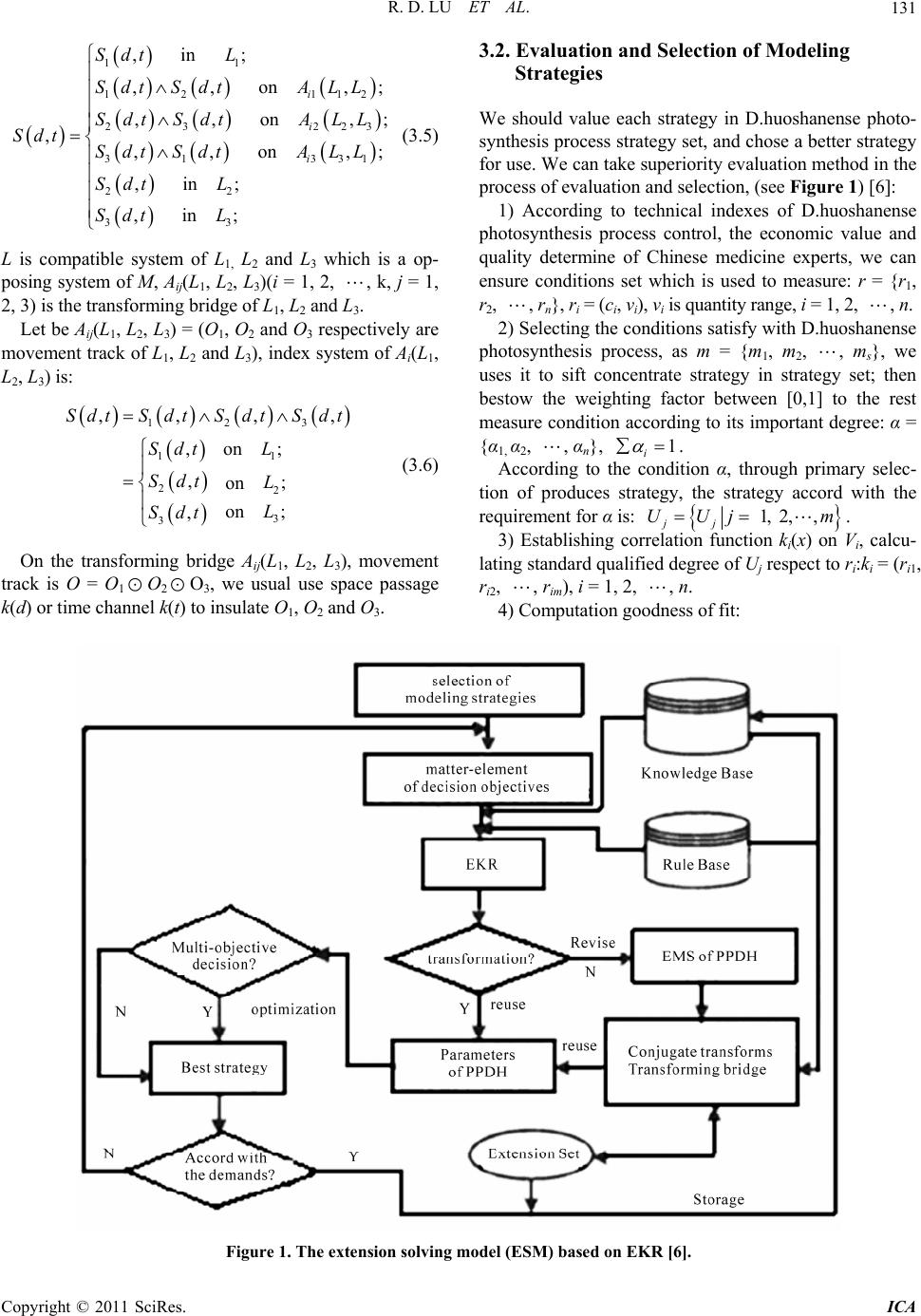 R. D. LU ET AL. Copyright © 2011 SciRes. ICA 131 2 3 1 ; ; ; 3.2. Evaluation and Selection of Modeling Strategies 11 12 11 23 22 31 33 22 33 ,in; ,,on, ,,on, ,,,on, ,in; ,in; i i i Sdt L SdtS dtA LL SdtSdtA LL SdtSdtSdtALL Sdt L Sdt L (3.5) We should value each strategy in D.huoshanense photo- synthesis process strategy set, and chose a better strategy for use. We can take superiority evaluation method in the process of evaluation and selection, (see Figure 1) [6]: 1) According to technical indexes of D.huoshanense photosynthesis process control, the economic value and quality determine of Chinese medicine experts, we can ensure conditions set which is used to measure: r = {r1, r2, , rn}, ri = (ci, vi), vi is quantity range, i = 1, 2, , n. L is compatible system of L1, L2 and L3 which is a op- posing system of M, Aij(L1, L2, L3)(i = 1, 2, , k, j = 1, 2, 3) is the transforming bridge of L1, L2 and L3. 2) Selecting the conditions satisfy with D.huoshanense photosynthesis process, as m = {m1, m2, , ms}, we uses it to sift concentrate strategy in strategy set; then bestow the weighting factor between [0,1] to the rest measure condition according to its important degree: α = {α1, α2, , αn}, 1 i . Let be Aij(L1, L2, L3) = (O1, O2 and O3 respectively are movement track of L1, L2 and L3), index system of Ai(L1, L2, L3) is: 123 11 22 3 3 ,,, ,on ; ,; on ; on , SdtS dtSdtSdt Sdt L Sdt L L Sdt , (3.6) According to the condition α, through primary selec- tion of produces strategy, the strategy accord with the requirement for α is: 1, 2,, jj UUj m. 3) Establishing correlation function ki(x) on Vi, calcu- lating standard qualified degree of Uj respect to ri:ki = (ri1, ri2, , rim), i = 1, 2, , n. On the transforming bridge Aij(L1, L2, L3), movement track is O = O1O2O3, we usual use space passage k(d) or time channel k(t) to insulate O1, O2 and O3. 4) Computation goodness of fit: Figure 1. The extension solving model (ESM) based on EKR [6]. 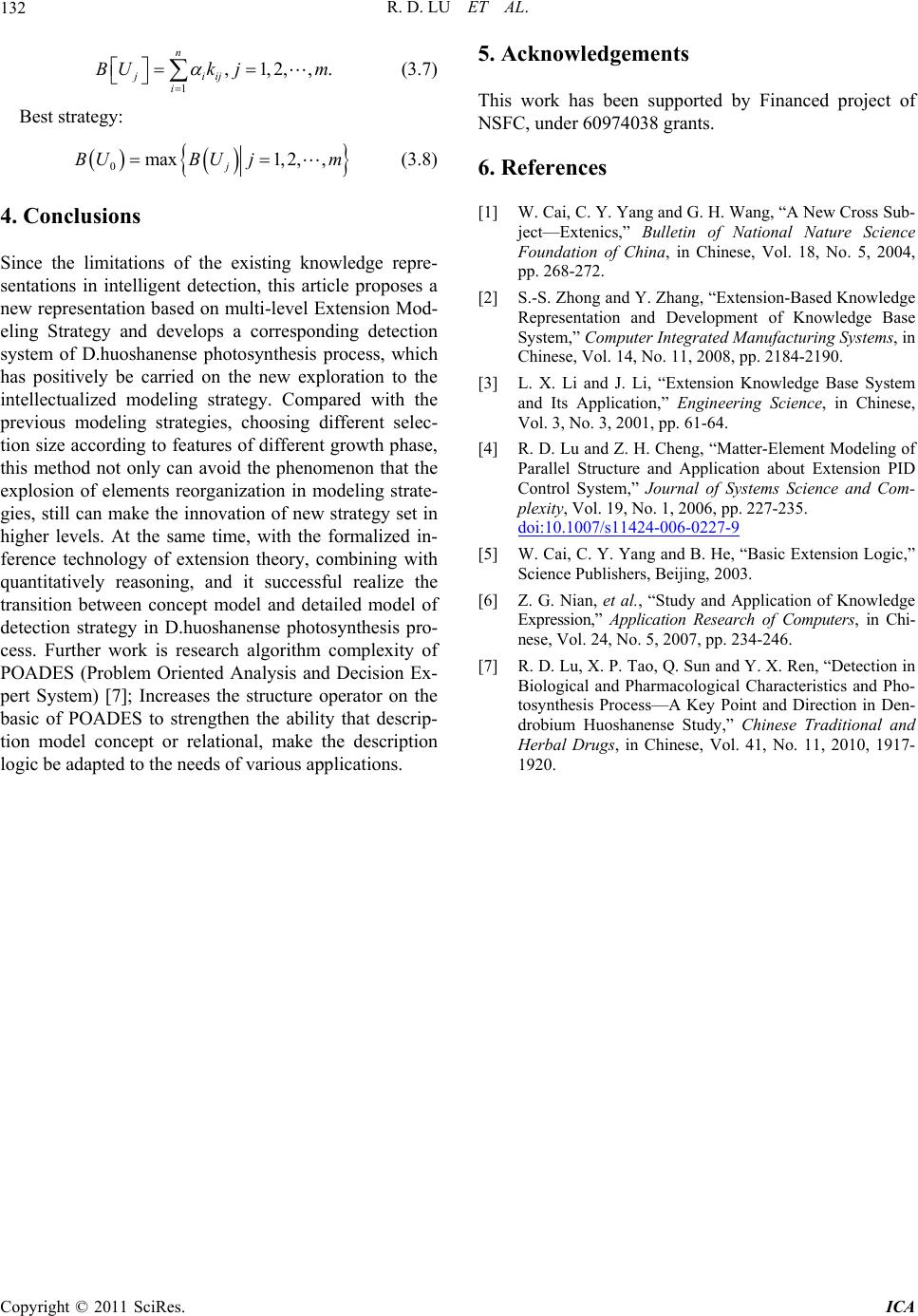 R. D. LU ET AL. Copyright © 2011 SciRes. ICA 132 1 ,1,2,, n jiij i BUk jm . (3.7) Best strategy: 0max1, 2,, j BUBU jm (3.8) 4. Conclusions Since the limitations of the existing knowledge repre- sentations in intelligent detection, this article proposes a new representation based on multi-level Extension Mod- eling Strategy and develops a corresponding detection system of D.huoshanense photosynthesis process, which has positively be carried on the new exploration to the intellectualized modeling strategy. Compared with the previous modeling strategies, choosing different selec- tion size according to features of different growth phase, this method not only can avoid the phenomenon that the explosion of elements reorganization in modeling strate- gies, still can make the innovation of new strategy set in higher levels. At the same time, with the formalized in- ference technology of extension theory, combining with quantitatively reasoning, and it successful realize the transition between concept model and detailed model of detection strategy in D.huoshanense photosynthesis pro- cess. Further work is research algorithm complexity of POADES (Problem Oriented Analysis and Decision Ex- pert System) [7]; Increases the structure operator on the basic of POADES to strengthen the ability that descrip- tion model concept or relational, make the description logic be adapted to the needs of various applications. 5. Acknowledgements This work has been supported by Financed project of NSFC, under 60974038 grants. 6. References [1] W. Cai, C. Y. Yang and G. H. Wang, “A New Cross Sub- ject—Extenics,” Bulletin of National Nature Science Foundation of China, in Chinese, Vol. 18, No. 5, 2004, pp. 268-272. [2] S.-S. Zhong and Y. Zhang, “Extension-Based Knowledge Representation and Development of Knowledge Base System,” Computer Integrated Manufacturing Systems, in Chinese, Vol. 14, No. 11, 2008, pp. 2184-2190. [3] L. X. Li and J. Li, “Extension Knowledge Base System and Its Application,” Engineering Science, in Chinese, Vol. 3, No. 3, 2001, pp. 61-64. [4] R. D. Lu and Z. H. Cheng, “Matter-Element Modeling of Parallel Structure and Application about Extension PID Control System,” Journal of Systems Science and Com- plexity, Vol. 19, No. 1, 2006, pp. 227-235. doi:10.1007/s11424-006-0227-9 [5] W. Cai, C. Y. Yang and B. He, “Basic Extension Logic,” Science Publishers, Beijing, 2003. [6] Z. G. Nian, et al., “Study and Application of Knowledge Expression,” Application Research of Computers, in Chi- nese, Vol. 24, No. 5, 2007, pp. 234-246. [7] R. D. Lu, X. P. Tao, Q. Sun and Y. X. Ren, “Detection in Biological and Pharmacological Characteristics and Pho- tosynthesis Process—A Key Point and Direction in Den- drobium Huoshanense Study,” Chinese Traditional and Herbal Drugs, in Chinese, Vol. 41, No. 11, 2010, 1917- 1920.
|